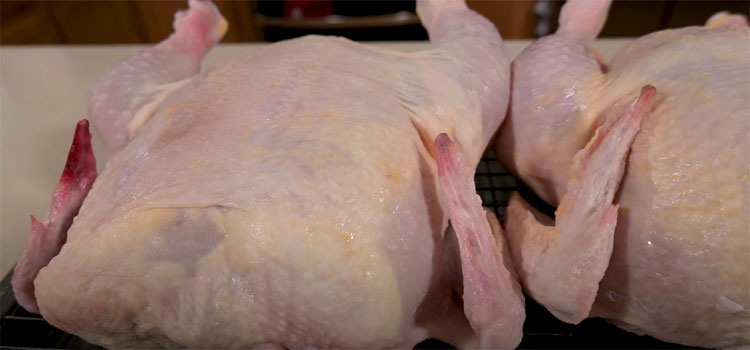Last Updated on September 15, 2024 by Shari Mason
Being a home cooking enthusiast, I always sniff out ways to save on ingredients. **Here’s a cool tip**: buying a whole chicken might save **more money** than getting pre-cut pieces.
We’ll explore the pros and cons of buying a whole chicken and discuss some tips for getting the most out of this versatile ingredient.
Is It Cheaper To Buy A Whole Chicken Than Pre-Cut Pieces?


Yes, it is cheaper to buy a whole chicken. When buying pre-cut pieces, you pay a premium for the convenience of having the chicken already portioned.
“I ate some pretty funky, authentic Chinese food in Hong Kong. There was an egg from some bird that’s not a chicken. I can’t remember what it was, but it was green and brown and not very tasty.”
– John Legend, American Singer
By buying a whole chicken, you can save money by utilizing the less expensive cuts, such as the wings and thighs, and have the bonus of using the bones and carcass to make homemade chicken stock [1].
While buying a whole chicken may require some extra work in terms of cleaning and portioning, the savings can be significant.
Advantages Of Buying A Whole Chicken
- Cost-effective: Whole chickens are generally cheaper per pound than pre-cut chicken pieces. Buying a whole chicken can save money in the long run, especially if you plan on using the leftovers for meals throughout the week.
- Versatility: Buying a whole chicken allows for more versatility in the kitchen. You can roast the chicken whole, break it into pieces for different recipes, or even use the bones and carcass to make homemade stock.
- Freshness: When you buy a whole chicken, you can inspect it for freshness and quality. This is impossible with pre-cut chicken pieces already packaged and sealed.
- More meat: A whole chicken typically yields more meat than pre-cut pieces of the same weight. This means more meals and leftovers for the week.
- Reduced waste: Buying a whole chicken reduces waste as you can use all of the chicken, including the bones, skin, and giblets [2]. This can also help to save money on other ingredients like chicken broth or stock.
Disadvantages Of Buying It


- Requires more time and effort to prepare: Buying a whole chicken means you have to spend time and effort preparing it, such as cleaning, cutting, and deboning. This may be daunting for some people not experienced in handling whole chickens.
- It may not be suitable for small households: A whole chicken may be too much for small households or individuals who cook for themselves. This could lead to waste and unnecessary spending.
- Can be more difficult to store: A whole chicken takes up more space in the fridge or freezer than pre-cut pieces. This can be a challenge for those with limited storage space.
- May require special equipment: Some recipes may require a roasting pan or other special equipment to cook a whole chicken properly. This can add to the overall cost of buying a whole chicken.
- Limited options for cuts: Buying a whole chicken means you are limited to the cuts available in the chicken, which may not include your preferred cuts. Preparing the chicken to your liking may require additional time and effort.
“The key to maximizing your grocery budget is knowing when to splurge and when to save. When it comes to chicken, opting for a whole bird can be a smart choice that saves both money and time in the kitchen.”
– Eat Pallet Restaurant & Food Advice
Tips For Buying & Preparing Whole Chicken
- Look for sales: Look for sales and deals on whole chickens at your local grocery store or butcher shop. Purchasing a whole chicken on sale can be more cost-effective than buying individual cuts.
- Check the freshness: When buying a whole chicken, check the expiration date and look for signs of freshness, such as firmness and pink color. A fresh chicken will also have a mild, pleasant odor.
- Consider the size: Think about how many people you’ll be cooking for and choose an appropriate chicken. A general rule of thumb is to plan for about 1 pound of chicken per person.
- Choose the proper cooking method: There are many ways to cook a whole chicken, including roasting, grilling, and slow cooking. Consider which method you prefer and plan accordingly.
- Use the entire bird: Don’t waste any part of the chicken. The bones and carcass can be used to make homemade chicken stock or broth, while the giblets can be used in various recipes.
- Be mindful of food safety: When handling and preparing a whole chicken, following proper food safety guidelines is essential. This includes washing your hands and utensils thoroughly, keeping the chicken at a safe temperature, and cooking it to the appropriate temperature to ensure it’s safe to eat.
FAQs
u003cstrongu003eIs whole chicken the cheapest meat?u003c/strongu003e
A whole chicken is often one of the cheapest meat options.
u003cstrongu003eIs it more sustainable to buy a whole chicken?u003c/strongu003e
Buying a whole chicken is more sustainable than buying pre-cut pieces as it reduces waste and can utilize more animal parts.
Final Thoughts
Buying a whole chicken can be cost-effective for those looking to stretch their grocery budget.
While it may require some extra effort to prepare and store, there are numerous advantages to purchasing a whole chicken, including versatility in the kitchen, less packaging waste, and potential savings.
However, it’s essential to consider your personal needs and preferences before deciding.
References:
- https://www.allrecipes.com/recipe/12983/basic-chicken-stock/
- https://www.thespruceeats.com/what-are-giblets-995697
- Can You Put an AC Unit in the Kitchen? - September 27, 2024
- What Cheese Does Olive Garden Use? Discover Their Signature - September 27, 2024
- How to Cancel a Pizza Hut Order? Quick & Easy Guide - September 24, 2024


